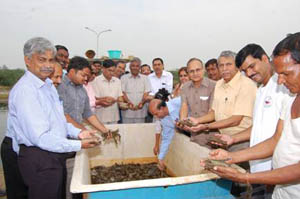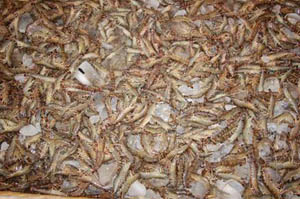The Rohtak Centre of Central Institute of Fisheries Education, Mumbai (Indian Council of Agricultural Research) has successfully demonstrated commercial farming of tiger shrimp ( Penaeus monodon) in inland ground saline water of Haryana through research innovation at it’s Lahli – Baniyani fish farm, Rohtak. Tiger shrimp (Penaeus monodon) which grows in seawater is considered as the best marine shrimp (prawn) in terms of growth, meat quality and market demand globally and it shares largest part of Indian fish export. Tiger shrimp did not survive in raw inland saline waters due to ionic difference with seawater.


The scientists of CIFE, Rohtak centre have however demonstrated that shrimp can be commercially farmed in inland saline waters with cost effective ionic management. In their last year’s trial, the seed of tiger shrimp was stocked into two identical ponds of 0.25 ha with seed broght from Kakinada (Andhra pradesh) @ 44,000/ ha ( PL-10) for 4 months culture duration in 10 ppt saliniy. The results indicated an overall survival of 65% with an average net production of 661.0 Kg/ha in 110- days culture duration.
This year in their recent filed trials with the judicious management practices they have achieved a net shrimp production of 1340 Kg/ ha with a survival of 84% in 110 days culture duration which is more or less equal to per hectare tiger shrimp production in coastal areas. This recent field trails have proved the validity of the technology developed by CIFE Rohtak Centre scientists. It is worth mentioning that tiger prawn is one such meat commodity which has got very high demand both in national and international markets and fetches very high price in comparison to chicken, mutton or most of the fishes available in the Indian market Since the culture duration for securing the crop tiger shrimp is only 4- summer months, the farmers of northern India can easily take two crops per year between March – November.
The technology developed by CIFE may be highly useful in terms of emerging problems of soil and water salinity. Around 6.1 million acres are affected with some form of salinity in India, which is rising with an alarming rate more particularly in north – western states. Saline lands are unfit for agriculture as it results in either poor or no crop. Various mitigating schemes like sub – surface drainage and construction of salt evaporation basins (developed in Australia and other developed countries) may not be much effective in India due to high input cost and small land holdings. These schemes need secondary utilization of water for profitable purpose so that the overall construction and operation cost may be offset from aquaculture produce. The CIFE in earlier demonstrations has also shown that many fish / prawn species of freshwater and marine nature may be cultured profitably in saline lands and ground saline water depending upon available water salinity. The centre has also developed the technology of seed production of giant freshwater prawn (Scampi) using inland ground saline water at Rohtak and initiated commercial supply of seed to the farmers of Haryana, Punjab and U.P. thus the area which has show signs of threat can be seen as an opportunity for producing high quality fresh seafood in the area thousands of kilometers away from sea.
The present technology developed by CIFE may bring prosperity to farmers whose lands have become saline and not fit for the growing of any other agricultural crops. The demonstration was held on 16 October 2009 in the presence of Dr. Dilip Kumar, Director CIFE as informed by Dr. V. K. Sharma, Officer – in – Charge of the Centre.
(Source : CIFE, Rohtak Centre)








Like on Facebook
Subscribe on Youtube
Follow on X X
Like on instagram